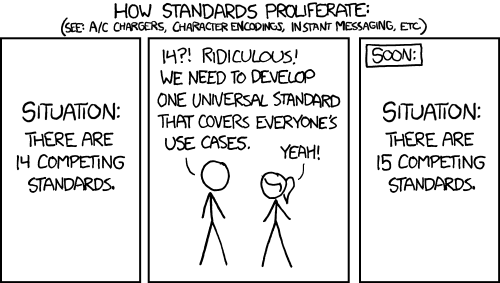Should it be identical to hyphen or should softhyphen simply be a zero width glyph?
It should be identical to the hyphen.
You can just add the Unicode of softhyphen to hyphen.
That’s true. Would the same apply to hyphentwo and nbhyphen?
Yes. IIRC hyphentwo was added to have a clear sole-purpose hyphen, whereas the original ASCII hyphen doubles functionally as minus, and is therefore described as ‘hyphen-minus’. The situation reminds me of this XKCD though:

There is a similar story with quote and apostrophe.
You are indeed right, that comic has reached a legendary status among everyone who deals with standards on a regular basis, a lot of folks, in other words.
About the quote/apostrophe debacle:
Does the single and double “dumb” quotation marks have any place within typography, or are they only remains of their ubiquity in typewriters?
I always use the single right quote for contractions (u+2019), so I don’t see much of a place for the straight quotation marks anywhere.
Technically, to support some more languages, you also need apostrophemod (U+02BC). And fonts need them of course, because all keyboard layouts are tied to the codes for the dumb quotes.
Technically they are dubbed ‘apostrophe-quote’ which stems from the undifferentiated implementation in ASCII. Some people use them as foot/minute and inch/second sign, which are now minute (U+2032) and second (U+2033). Some people like to design them differently (more slant).
What is apostrophemod used for? I have seen it within a few typefaces, but never heard of its use cases.
Latin Belarusian and Cyrillic Ukrainian, for instance.
Edit: could both be Cyrillic, not sure now myself.
Ah, thanks!
The modifier letters tend to be used for the IPA (International Phonetic Alphabet).
Quoting UnicodeChecker’s Misc text on U+02BC
• glottal stop, glottalization, ejective
• many languages use this as a letter of their alphabets
• used as a tone marker in Bodo, Dogri, and Maithili
• 2019 is the preferred character for a punctuation apostrophe
That «some» is almost everybody. Hard to imagine for us Europeans, but millions of people have to deal with inches, and the inch and single straight quote are standard keyboard keys. Grown up apps replace straight quotes with typographic quotes automatically, depending on country settings. I do not think there are standard shortcuts for curly quotes in Windows, I don’t want to learn alt+4-number codes to type them, lazy me.
But if people used the proper inch and foot marks (if they were, say, part of standard keyboard layouts), the straight/dumb quotes would be obsolete, right?
People already use the proper inch and foot marks.
And these are already part of standard keyboard layouts.
So no, straight quotes will never be obsolete.
Just that they are actually not quotes, and not dumb either, as they are capable of communicating quotes and several other things, depending on context.
https://www.fonts.com/content/learning/fontology/level-3/signs-and-symbols/correct-marks
Prime symbols should have a slant, but I prefer straight quotes for inches and feet.
Oh, so an acceptable in all (contexts), preferred in none, type of thing?
That would be similar to the hyphen-minus, then.
No, straight quotes are definitely not acceptable instead of curly quotes in a printed book, and preferred as inch symbol by many.
If Unicode were to be remade from the ground up, would straight quotes be included, or would you only see the set of curly quotes and primes?
They will be included before anything else, because the world is full of real life use. And because Unicode would start with existing code pages, existing keyboards etc.
Do you have a problem with straight inch symbols?
Not at all; I’m just starting to grasp this interesting topic, and found that asking the experts directly was the best way to go about it. Thank you for all your wonderful insight!
Absolutely fantastic question, by the way; I’ll treasure this one for years to come!